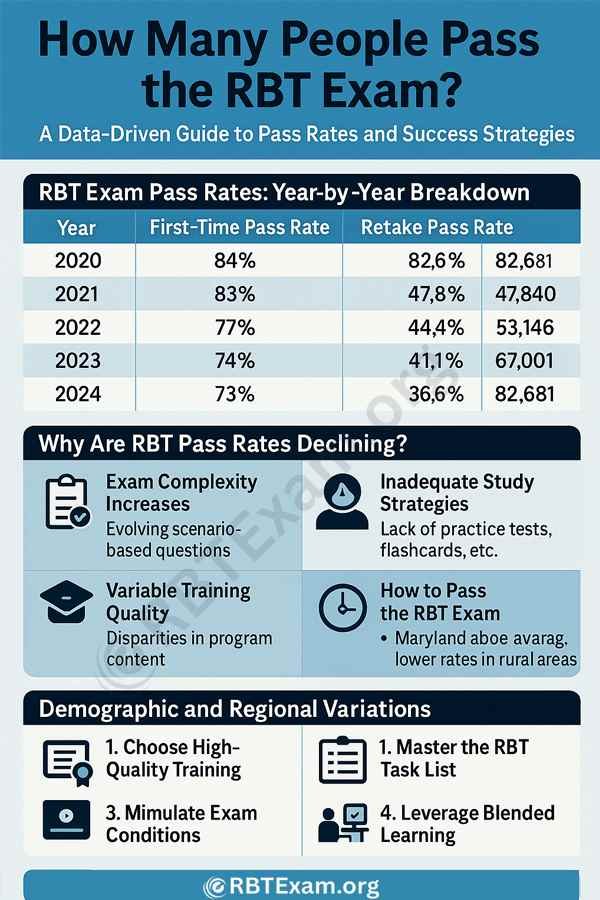How Many People Pass the RBT Exam? A Data-Driven Guide to Pass Rates and Success Strategies
The first-time pass rate for the RBT exam in 2024 was 73%, while retake pass rates dropped to 36%, according to BACB annual data . Over 82,000 individuals became newly certified RBTs in 2024, with 196,579 active certificants by year-end. Pass rates have declined steadily since 2020 (84%) due to evolving exam rigor and training quality disparities .
Aspiring Registered Behavior Technicians (RBTs) especially need to know these figures. This book delves deeply into historical trends, demographic analysis, and practical advice to increase your chances of passing. We will examine BACB findings, best practices in top training courses, and typical mistakes to provide you statistically supported preparation tools.

RBT Exam Pass Rates: Year-by-Year Breakdown
The Behavior Analyst Certification Board (BACB) releases annual pass rate data. The pass rate can be influenced by understanding how many questions are on the RBT exam. Here’s how performance has shifted since 2020:
RBT Exam Pass Rates (2020–2024)
| Year | First-Time Pass Rate | Retake Pass Rate | Total New RBT Certifications |
|---|---|---|---|
| 2024 | 73% | 36% | 82,681 |
| 2023 | 74% | 41% | 67,001 |
| 2022 | 77% | 44% | 53,146 |
| 2021 | 83% | 46% | 47,840 |
| 2020 | 84% | 52% | 40,460 |
Key Trends:
- 11% drop in first-time pass rates since 2020 .
- Retake success rates are 50% lower than first attempts, emphasizing the need for thorough initial preparation.
- Certification numbers grew by 104% from 2020–2024, reflecting surging demand for ABA services .
Why Are RBT Pass Rates Declining?
Multiple factors contribute to the downward trend:
1. Exam Complexity Increases
The BACB periodically updates the RBT Task List to reflect evolving best practices. Recent versions emphasize scenario-based questions, requiring applied knowledge over rote memorization. For example, 60% of 2024 exam questions tested real-world behavior intervention planning .
2. Variable Training Quality
Programs with BACB-aligned curricula (e.g., ATCC Online) achieve 86.5% first-time pass rates—far above the national average . Conversely, free or outdated courses often lack:
- Competency assessments (Keep in mind, the RBT exam also includes a practical component—the competency exam.)
- Mock exams
- Interactive RBT study chatbots (linked to 20% higher retention) .
3. Inadequate Study Strategies
Per BACB data, candidates who used these methods passed at higher rates:
- Practice tests (85+ questions): 89% success .
- Flashcards for ABA terminology: 78% success .
- Time management drills: 92% completed the exam within 90 minutes .
Pro Tip: Explore the free RBT Task List to align your study plan with tested domains RBT Task List Guide. To improve your chances, follow these tips to pass the RBT exam.
Demographic and Regional Variations
Pass rates differ across groups:
Demographic Pass Rate Comparisons
| Group | First-Time Pass Rate | Notes |
|---|---|---|
| Women | 90.1% | Higher engagement with mentorship programs . |
| Men | 77.8% | Often skipped practice exams . |
| Hybrid Learners | 96.7% | Combined online training + face-to-face coaching . |
| Self-Studiers | 68% | Limited access to BCBA feedback . |
State Differences:
- Maryland’s pass rates consistently exceed national averages due to state-funded training initiatives .
- Rural areas face 15% lower pass rates from limited in-person supervision .
How to Pass the RBT Exam on Your First Attempt
1. Choose High-Quality Training
Top programs like AppleTree Connection and ATCC offer:
- Live BCBA mentorship
- Mock exams with 500+ questions
- Competency assessment prep .
2. Master the RBT Task List
Focus on these heavily weighted areas:
- Behavior Reduction (30% of exam): Antecedent interventions, extinction procedures.
- Skill Acquisition (25%): Prompting hierarchies, reinforcement schedules.
- Ethics (20%): Client dignity, confidentiality laws .
Resource: Download a detailed RBT study guide with domain breakdowns RBT Study Guide.
3. Simulate Exam Conditions
- Take timed 75-question practice tests weekly RBT Practice Test.
- Review incorrect answers with a BCBA supervisor.
4. Leverage Blended Learning
Candidates using online + in-person training had a 96.7% pass rate—the highest of any group .
FAQs
Q: What’s the hardest part of the RBT exam?
A: Scenario-based questions (e.g., “Which intervention aligns with the client’s BIP?”) trip up 62% of failing candidates .
Q: How long should I study?
A: 4–6 weeks (1–2 hours daily) is ideal. Those studying <3 weeks have a 58% pass rate .
Q: Are pass rates higher for certain age groups?
A: No. BACB data shows no significant difference by age or education level .
Final Thoughts
While RBT exam pass rates are declining, strategic preparation can position you above the average. Prioritize BACB-endorsed training, active recall techniques, and real-world application. For further reading, explore the BACB’s official exam structure guide RBT Exam Structure.
Need more help? Bookmark this 75-question RBT practice test to benchmark your readiness RBT Practice Test.






